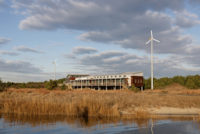New Plaintiffs Join Amended LEED Lawsuit
A federal lawsuit filed in October 2010 against the U.S. Green Building Council (USGBC) and other defendants, focusing on allegedly fraudulent claims of the LEED rating system, has been amended. Filed February 7th, 2011, the amended complaint has been boiled down to a claim of false advertising, and is no longer a class-action suit.
As with the original lawsuit (see USGBC, LEED Targeted by Class-Action Suit), the amended version focuses on a critique by Henry Gifford, a mechanical systems consultant, that USGBC falsely claims that LEED guarantees energy savings in LEED-certified buildings.
Harm to non-LEED APs
Instead of seeking to establish a broad class-action lawsuit representing building owners, taxpayers, and professionals harmed by LEED, the amended lawsuit focuses on the latter. It claims that Gifford and other professionals are, in the words of the complaint, “losing customers because USGBC's false advertisements mislead the consumer into believing that obtaining LEED certification incorporates construction techniques that achieve energy-efficiency.” The suit seeks an injunction and damages against USGBC.
Instead of seeking to form a class of plaintiffs harmed by LEED, Gifford brought on three other professionals to the complaint: an architect and two engineers. Other defendants named in the original suit, including Rick Fedrizzi, David Gottfried, and Rob Watson, all associated with the founding of LEED, have been removed.
A “cleaner” suit
The amended suit is “cleaner” according to Stephen Del Percio, a lawyer and author of the blog GreenRealEstateLaw.com. “It doesn't have to go through the certification of the class and that sort of hurdle toward getting to the merits,” he says, noting that it remains to be seen whether the change would work in the favor of either party.
Del Percio says that the allegations are fundamentally unchanged, as is one of the central legal questions—whether the plaintiff has standing. In other words, regardless of Gifford’s claims that USGBC misrepresented the benefits of LEED, it is unclear whether he and the other plaintiffs have sufficient stake in the question, as they might, for example, if they were mislead into wasting money on LEED certification for a building project. Del Percio and other observers anticipate that USGBC will move to dismiss the case on this basis, but that it could possibly move toward a discovery phase, in which internal communications at USGBC could be made public.
Plaintiff comments
One of the newly added plaintiffs, Andrew Äsk, P.E., a Florida-based engineering consultant, elaborates on how he was harmed by USGBC: “It is becoming more common for institutional owners to be listing LEED credentials as a requirement to do work for them,” he says. “Since I don't subscribe to USGBC I am shut out of most projects.”
Äsk complains that over-reliance on the LEED Accredited Professional (LEED AP) credential leads to incompetent, less-experienced people taking work from more experienced professionals. When questioned whether, were that to be true, it would warrant a lawsuit, Äsk points to Gifford’s analysis showing that the LEED system has been “unfairly strengthened by USGBC’s false advertising.” He says that he is supportive of USGBC’s environmental goals, but not its methods, which Äsk characterizes as “certifying buildings prospectively without proving that they are going to save energy.”
To assess energy savings, Äsk says, “Let's build the building, occupy it, and then read the meter.” When asked his opinion of USGBC’s LEED for Existing Buildings rating system, which includes water and energy metering and performance requirements (some of which are also being incorporated into LEED for New Construction through USGBC’s Building Performance Partnership), Äsk admitted that he wasn’t aware of the system. “I would back off from my claim” to the extent that it operates as described, he adds.”
Taryn Holowka, director of communications for USGBC, says that USGBC recently just received the amended lawsuit and is evaluating it. The deadline for USGBC’s legal response is April 7th. As with the orginal lawsuit, the amended version was filed by Norah Hart of Treuhaft and Zakarin.
Gifford’s critique
As previously reported, at the heart of the lawsuit is Gifford’s critique of a 2008 study from New Buildings Institute (NBI) and USGBC that is, to date, the most comprehensive look at the actual energy performance of buildings certified under LEED for New Construction and Major Renovations (LEED-NC). While the NBI study makes the case that LEED buildings are, on average, 25–30 percent more efficient than the national average, Gifford published his own analysis in 2008 concluding that LEED buildings are, on average, 29 percent less efficient. Commentary questioning the respective statistical approaches of both the original study and Gifford’s analysis appears in this blog post by Nadav Malin, president of BuildingGreen.
Copyright 2011 by BuildingGreen, LLC


